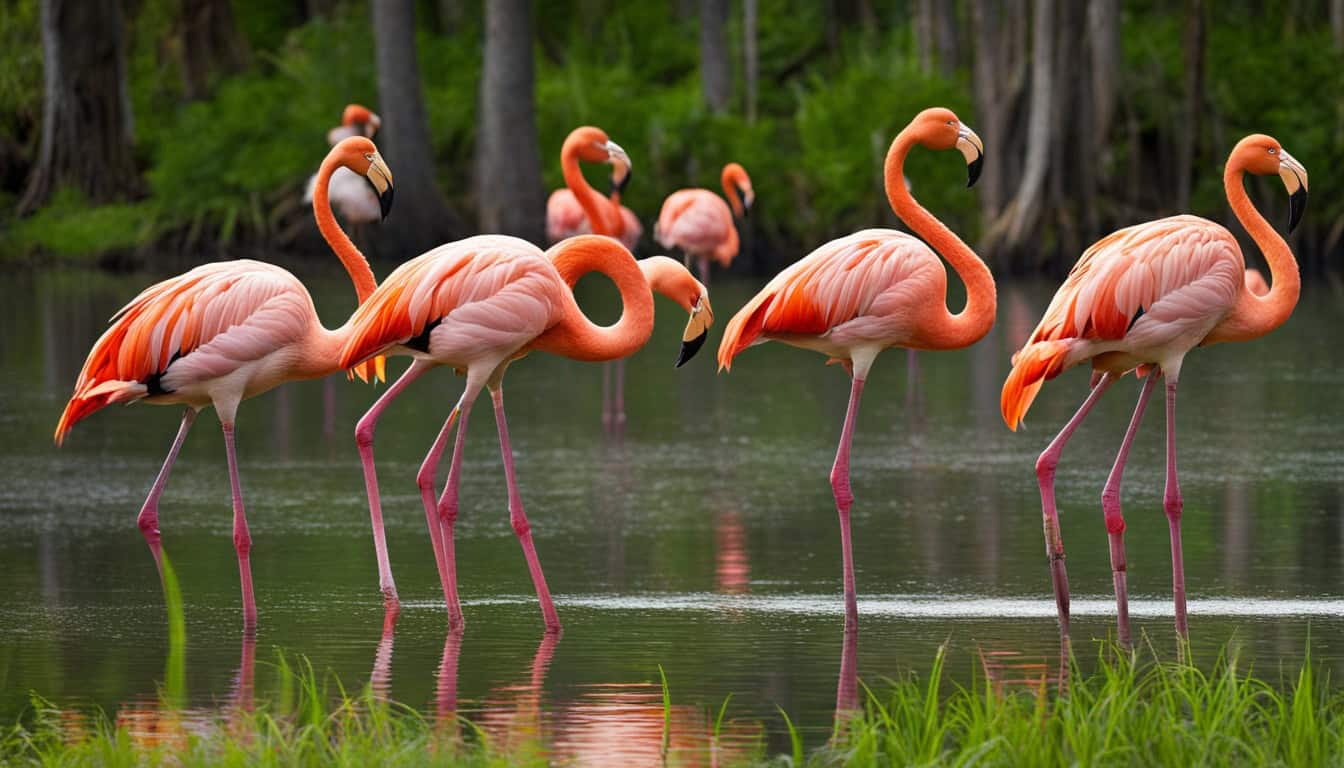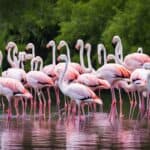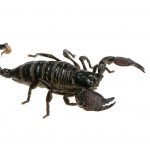The American flamingo, known as Phoenicopterus ruber, is native to the West Indies, northern South America, and the Yucatan Peninsula. It was once common in southernmost Florida, making it a native species there. They are now rare in the USA, but not endangered.
Flamingos in the USA were plentiful in Florida until about 1900. Extensive hunting greatly reduced their numbers. However, now there are signs of them coming back, possibly helped by storms.
Introduction to American Flamingos
The American flamingo, or Phoenicopterus ruber, is known for its bright, reddish-pink feathers. It’s the largest flamingo type in the Americas. It’s also the only flamingo naturally found in North America. These flamingos live in the Caribbean, northern South America, and the Galápagos Islands. They used to be in Florida too.
The IUCN marks these flamingos as “Least Concern.” They live in saltwater lagoons, mudflats, and shallow lakes near the coast. These areas are perfect for them to find food. Thanks to their habitat’s preservation efforts, their population is stable or growing.
The Phoenicopterus ruber is a key part of the local wildlife where they live. Learning about their role helps keep them safe. Conservation efforts protect these beautiful birds and their environment.
Historical Presence of Flamingos in Florida
American flamingos used to live abundantly across Florida’s wetlands and coasts. The naturalist John James Audubon noted these colorful birds in the thousands. Their vibrant pink tones brightened Florida’s landscapes.
Early Records and Observations
In the 19th century, naturalists described seeing large flocks of flamingos. These early observations highlighted the bird’s wide and abundant population. Collections of flamingo eggs from that time show how common they were in Florida.
Population Decline by the 20th Century
By the early 1900s, the number of American flamingos in Florida dropped drastically. Both Native Americans and settlers hunted them heavily. This hunting, for feathers and flesh, severely affected their population and behaviors.
The consequences of human actions almost led to their regional disappearance. Yet, memories of these once common birds live on through stories and preserved specimens.
Current Status of Flamingos in Florida
Florida’s flamingos have caught the eye of bird fans and experts. They’re starting to live here permanently again. This is clear from how often they’re spotted.
Recent Sightings and Resident Populations
More and more flamingos are being seen in Florida recently. This suggests they might stay all year round. They often hang out in places like the Everglades and the Florida Keys.
Seeing them regularly gives hope that they’re here to stay.
Role of Storms and Migration Patterns
Wild weather, like Hurricanes, has made a big impact on these flamingos. For example, Hurricane Idalia in 2023 brought many to Florida. This actually helps them spread out more naturally.
It shows how these beautiful birds move around, affecting where we see them.
Are there any native flamingos in the USA?
Many people wonder: are there any native flamingos in the USA? The answer, backed by research and history, is yes. Native flamingos, specifically in Florida, have a strong case. This conclusion is shared by experts in bird studies and wildlife.
There is clear evidence of flamingos being native to the USA. Sightings and reports of them breeding support this. Especially, early naturalists reported seeing big flamingo flocks in Florida’s southern parts.
Today, efforts to protect native flamingos are on the rise. These actions aim to keep the USA’s flamingo status by safeguarding their homes. It’s critical we value flamingos as a part of America’s nature and help them flourish in the wild.
| Aspect | Details |
|---|---|
| Historical Sightings | Recorded in Florida since the 19th century |
| Breeding Activities | Confirmed through consistent observations and studies |
| Conservation Efforts | Focused on habitat protection and reducing human disturbances |
| Consensus Among Experts | Strong support for native status in Florida |
Florida’s Flamingos: Iconic Symbol of the State
Flamingos are deeply linked with Florida, making them a symbol of the state. This connection comes from both past flamingo populations and the Flamingo Hotel. Many famous places have also played a big role in this.
Flamingo Hotel and Merchandise Influence
The Flamingo Hotel in Miami Beach is a key reason why flamingos are so famous in Florida. By using flamingos in their logos and selling lots of flamingo items, they’ve made the bird part of Florida’s image.
Captive Populations in Hialeah Park
Even though wild flamingo numbers in Florida have fallen, places like Hialeah Park keep them going. Hialeah Park’s flamingos are a big draw, adding beauty and culture to the state.
| Aspect | Flamingo Hotel | Hialeah Park |
|---|---|---|
| Role | Tourism and Cultural Influence | Preservation of Species |
| Location | Miami Beach | Hialeah |
| Primary Contribution | Iconic Symbol Through Branding | Captive Breeding Programs |
| Popularity | High | Moderate |
Distribution of American Flamingos
American flamingos live in many places, including the Caribbean and parts of South America. They can also be found in the Galápagos Islands and the Yucatan Peninsula. In the U.S., they are becoming more common in Florida. This is because Florida has the right places for them to live and have babies.
Geographical Range
American flamingos have a huge area where they can live. They are often seen in the Caribbean, in countries such as Cuba and Jamaica. They also live in northern South America, near places like Venezuela and Colombia.
Big groups of flamingos can be found in the Galápagos Islands and the Yucatan Peninsula in Mexico. In the U.S., they have been spotted in Florida. This includes places like the Everglades and the Florida Keys, showing that they might be coming back to these areas.
Habitats and Preferred Ecosystems
American flamingos really like certain places where they can find food and raise their young. They prefer shallow, salty waters where they can eat brine shrimp and algae. These foods give them their bright pink feathers.
In Florida, this means they are often seen in the Everglades and Biscayne Bay. These places have the warm shallow waters the flamingos love. Protecting these water habitats helps keep the flamingo populations healthy.
Role of Conservation and Protections
Flamingo conservation relies on both global and local actions. The American flamingo is a protected species thanks to the Federal Migratory Bird Treaty Act. This act ensures they are safe from harm and helps protect their homes.
Habitat protection is key to supporting flamingos. This means saving the places they live, like saline lagoons and coastal lakes. It also involves reducing harmful impacts from things like cities and tourism.
Flamingo populations seem okay for now, but we must keep watching them closely. This involves studying their homes, how they move, and how they handle the climate. Working with groups worldwide makes our efforts stronger.
The table below shows how flamingo conservation efforts are helping:
| Conservation Measure | Impact | Region |
|---|---|---|
| Habitat Protection | Increased stability in population | Florida, Caribbean |
| Human Activity Management | Reduced disturbances and pollution | Coastal Regions |
| Climate Event Monitoring | Better preparedness and response | North America |
To help American flamingos continue living in the wild, conservation is crucial. By tackling threats with specific actions, we work towards their continued survival.
Distinguishing American Flamingos
The American flamingo is easy to spot because of its reddish-pink feathers. They also have black wingtips. This makes them stand out to people who enjoy watching birds.
Physical Characteristics and Plumage
American flamingos have very special physical features. They have long necks and legs, great for walking in water. Their uniquely shaped beaks help them eat by filtering the water.
The bright pink color of their feathers comes from their food. This food is full of special pigments from things like shrimp and algae.
| Feature | Description |
|---|---|
| Feathers | Reddish-pink with black wingtips |
| Beak | Specialized for filter-feeding |
| Legs | Long and slender, ideal for wading |
Behavior and Social Structure
American flamingos love to be with others. They form big groups and have interesting ways of interacting. These birds are often found in pairs that stick together. They also share places for taking care of their eggs and chicks.
In their groups, there are leaders. These leaders often decide where to look for food and where to build their nests. This kind of social life helps them all do well, especially when it’s time to raise their young.
Famous Locations to See Flamingos in the USA
Want to see the beauty of American flamingos up close? There are many places in the USA to do just that. Florida stands out as a top spot. You can see these amazing birds in their natural home. The Everglades and Florida Keys are perfect for spotting flamingos in the wild.
But not just in the wild, you can also see them at zoos and sanctuaries. Places like Hialeah Park in Miami, Busch Gardens in Tampa, and the San Diego Zoo have many. These spots are great for both fans and those looking for something fun to do.
Other great places include the Philadelphia Zoo and the Houston Zoo. They are known for their big bird areas, especially for American flamingos. These are amazing places to enjoy both wild and captive flamingo sightings.
Mating and Bonding Behavior of Flamingos
American flamingos have fascinating mating and bonding behaviors. These are central to their success in reproduction. Their behaviors are detailed and show complex patterns.
Monogamy and Nesting
During the breeding season, flamingos form monogamous pairs. Both the male and female work together to build nests and protect their chicks. The nests are mounds made of mud, sticks, and stones. They are placed strategically to keep the eggs safe from flooding and predators.
Courtship Rituals
American flamingos take part in detailed courtship rituals. These are important for bonding and mating success. The rituals include synchronized movements like head-flagging and wing-saluting. They even have a special dance. This dance shows they are ready to mate. All these rituals help in mating and build strong pair bonds. These bonds are vital for raising their young together.
Comparison with Other Flamingo Species
When we compare flamingo species, we often look at the American flamingo and the Greater flamingo. They look similar but have some key differences. For example, the American flamingo has brighter reddish-pink feathers. These stand out against the paler pink of the Greater flamingo. The American flamingo gets its bright color from its diet. Their food is full of carotenoids from algae and tiny sea creatures.
| Characteristic | American Flamingo | Greater Flamingo |
|---|---|---|
| Plumage Color | Reddish-Pink | Pale Pink |
| Average Height | 47-57 inches | 43-59 inches |
| Geographic Distribution | Caribbean, South America, Florida | Europe, Africa, South Asia |
| Preferred Habitats | Saline Lagoons, Mudflats, Coastal Lakes | Estuaries, Mudflats, Salt Lakes |
Their ranges are different too. American flamingos live in the Caribbean and parts of South America, and sometimes in Florida. On the other hand, Greater flamingos are seen in Africa, Europe, and Asia.
Their favorite living places are different too. The American flamingo loves places like saline lagoons and coastal lakes. Greater flamingos, however, prefer estuaries and mudflats. This tells us a lot about their lifestyles and behaviors.
Studying the differences between these flamingos helps bird experts and fans learn about their lives. By looking at their features and actions, we see how diverse flamingo species are. And we learn what makes the American and Greater flamingos unique.
Interaction with Human Activities
Human activities affect flamingos greatly. Things like building in cities, seeing them in nature without harm, and setting up special areas for wildlife all change their world.

Impact of Urban Development
Big cities have not been good for flamingos in the past. They lose their homes when buildings and roads are made. Wet places they need for food and babies often become fields or more buildings. It’s tough for them to live without these special areas.
- Habitat loss from construction
- Disruption of breeding grounds
- Pollution from urban runoff
Tourism and Wildlife Sanctuaries
Seeing flamingos and the work to keep them safe is now a big help. Places where they can live, and people can learn about them, are being protected. This is good news for the pink birds.
When people travel to learn about flamingos and places where they are safe, it helps. Money they spend can be used to do more to keep the birds safe. Also, this kind of travel is best when it doesn’t hurt the places or animals we visit.
- Establishment of protected areas
- Promotion of eco-friendly tourism
- Educational programs for conservation awareness
| Benefits | Challenges |
|---|---|
| Revenue for conservation | Habitat disturbance |
| Increased awareness | Overcrowding of tourist spots |
| Preservation of natural habitats | Potential pollution from tourism activities |
It’s important to balance what we do with what flamingos need. Making cities better and traveling wisely can keep these birds around. Let’s enjoy these amazing creatures while helping them live their best life.
Future Prospects for Flamingos in the USA
American flamingos in the USA, especially Florida, have a future that looks hopeful. They are now seen as a part of the natural ecosystem, leading to serious conservation work. You might start seeing more of these stunning birds thanks to efforts for their survival.
Due to storms and new migration paths, sightings of flamingos are rising. This shows they might be making a comeback all by themselves. Continuous research and conservation work are helping them thrive and become part of the American scenery once more.
Your help and understanding of this issue are crucial. Pushing for conservation and protection of their homes can help these birds prosper. As a result, future generations will have the joy of seeing flamingos in the wild.
FAQ
Are there any native flamingos in the USA?
Yes, American flamingos are native to the USA, especially in southern Florida. There is strong historical and recent evidence to support this.
What are American flamingos?
American flamingos are big, reddish-pink birds. They are known as Phoenicopterus ruber. They are found in parts of North America, the Caribbean, and northern South America.
What historical presence did flamingos have in Florida?
In the past, Florida was full of flamingos, noted by people like John James Audubon. But their number sharply dropped in the early 20th century because of hunting and loss of habitat.
What is the current status of flamingos in Florida?
Today, there are few flamingos in Florida. Yet, there’s hope for more, especially after storm events that guide them back to the area.
Are flamingos native to the USA?
Yes, it is now widely believed that flamingos are native to the USA. This is supported by historical insights and ongoing studies.
How are flamingos an iconic symbol of Florida?
In Florida, flamingos are big symbols. They are seen in places like the Flamingo Hotel and Hialeah Park. This keeps them iconic in the state.
What is the geographical range of American flamingos?
American flamingos are found throughout the Caribbean, northern South America, and the Yucatan Peninsula. Historic and recent sightings also place them in southern Florida.
What role does conservation play for American flamingos?
Conservation is very important for American flamingos. Efforts to protect their homes are vital. This includes work in areas like Florida to help them thrive.
How can you distinguish American flamingos?
You can tell American flamingos by their reddish-pink color and black wingtips. They are known for their social behavior, including pairing and group courting.
Where can you see flamingos in the USA?
Look for wild flamingos in Florida’s Everglades, Biscayne Bay, and the Florida Keys. You can also see them in zoos and sanctuaries.
What are the mating and bonding behaviors of flamingos?
Flamingos pair up monogamously during breeding. Both parents help raise the young. They show off synchronized dances to find love and a place to nest.
How does the American flamingo compare with other flamingo species?
The only flamingo in North America is the American flamingo. It differs from others in size, color, and where it lives.
How have human activities impacted flamingos?
People have hurt flamingos through development. But they have also helped by creating safe places and promoting visits to see these birds.
What is the future of flamingos in the USA?
Things are looking up for flamingos in the USA, Florida especially. Efforts to confirm their native status and protect them are ongoing.







